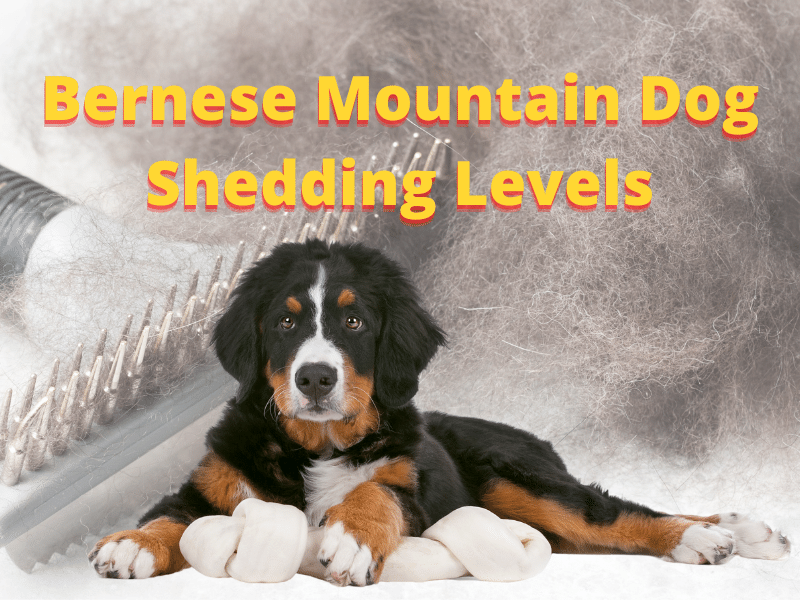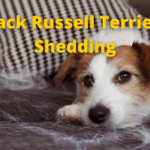
Dog shedding is a normal process for dogs in which the hair falls out from their body. It’s beneficial for your dogs to help them maintain their dog coat. Thus it’s good for your health too. When you have a Bernese Mountain Dog, you have to pay a price for beauty, the form of shedding.
So, yes, the Bernese Mountain dogs shed a lot, but when and at what time of the year? We’ll help you to know in this article.
Not only this, but we’ll also guide you on what steps you can take to stay worry-free when your Bernese Mountain Pup is shedding.
Contents
Do Bernese Mountain Dogs Shed a Lot?
Bernese is one of the highly shedding breeds as they’re a double-coated breed. That means the Bernese have plenty of furs to lose.
According to the American Kennel Club, Bernese mountain dogs are at number 21 among the dog breeds that shed the most. Hence, they shed more than 10 percent of all other dog breeds.
Yet, their heavy shedding is seasonal, and the rest of the time they shed moderately.
Bernese Dogs Shedding Seasons
Bernese is a mountain dog that belongs to an extremely versatile working breed. So, being from the mountains, they have a double-coat. Their long and beautiful thick coats have made them an attraction for all dog lovers. Their topcoat is designed to protect them from unusual elements, making them shed a lot seasonally.
The reason is that Bernese’s undercoat gets thicker in winter and thinner in summer. When they need to regrow fresh and long hair. Yet, they keep on shedding moderately around the year.
This thickening thinning makes them shed a lot, occasionally. In contrast, their topcoat maintains a moderate shedding level like other dogs.
As a rule of thumb, it’s usual to spot a ring of hair where your dog has been sleeping.
For dogs that shed hair seasonally, most shedding of fur occurs at the time of spring and fall. You’ll notice that your Bernese mountain dog coat will become lighter in the spring: February and March, in preparation for the warm weather.
In the fall, as they’re preparing for winters, you will see a change in dog coats and a higher rate of hair shedding from September to November. In the months of spring, their winter coat gets lighter as the loose dog hair helps them maintain the temperature in summers. This process is also known as “blowing their coats”.
Bernese Mountain Dog Breeds’ Shedding According to Age
Bernese mountain dogs start to shed hair after 12 weeks of their birth, usually starting from 4 to 6 months of age, but it is seen that some dogs start shedding even from the 12th week, and it’s quite normal.
Shedding of dog fur coats can last up to 1 year of age. After that, the mature growth period of Bernese starts. However, Bernese shedding hair is a life-long process that is carried throughout the lifespan of a Bernese mountain dog.
This process will demand less shampooing and weekly brushing to get rid of hair.
Bernese Mountain Dogs’ Frequency of Shedding
As you know, Bernese dogs are year-round shedders, and the intensity of their shedding grows during summer and winter; they have a long hairy fur coat which helps in this regard.
The hair they lose is more noticeable than a German shepherd or any other dog breed with a thick double coat. Depending on the temperature outside, their undercoat gets a way to become thicker or thinner.
When your Bernese is blowing his coat, you have to take special care of them. You have to brush the Bernese regularly shed any excess hair out of their outer fur coat.
You can also keep the dog grooming regime in mind to maintain the health and hygiene of your Bernese Mountain dog. In this regard, feeding your pup a healthy and nutrition-rich diet can be of great help.
Do Bernese Mountain Dog Puppies Shed more than the Adult ones?
There is nothing cuter than a puppy, don’t you think so? The soft puppy coats of the Bernese Mountain dog puppies attract kids and adults.
Unfortunately, the loss of an old puppy coat is a normal part of your Bernese Mountain dog’s growth. And, it can worry the first-time owner of a Bernese dog.
But what’s the difference between the dog’s coat of a puppy and an adult Bernese Mountain Dog? Who sheds more, puppies or an Adult Bernese Mountain Dog?
Just like other dog breeds, Bernese Mountain dog puppies are born with a single fur coat that is soft and fluffy. This helps them regulate their body temperature.
These puppy coats are usually thinner, but shedding hair or fur coat makes their coat thicker and stiff within time. They grow their distinct coats, some short and curly and others long and silky. These comprise two layers of adult fur coats: a shorter undercoat and a longer outer coat.
You can hope your Bernese Puppies lose their dog hair or fur coats at the age of 4 to 5 months. During this period, your Bernese puppy will go through a whole phase of shedding hairs for a few months known as “the uglies.”
Your Bernese pup may look a little ruffled, patchy, or shaggy as their adult coat comes in. Hence, shedding hair in puppies seems more than adult ones; even the breed who are non-shedder will shed a small number of hair when they are puppies.
The amount of hair loss can be different. Take it as an example; if a puppy is hardly shedding any hair, there are still chances that the hair losses become more within the growth period in adulthood. Maybe your puppy, who is shedding more in its puppyhood, will shed less in adulthood.
Loss of fluffy old hair is normal, but not all hair loss is normal. As a dog owner, you have to take your Bernese Mountain Dog pup for full examination if he is exhibiting exceptional hair loss or any symptoms such as bare patches on the skin, scaly skin, redness or inflammation, loss of large patches of fur, and excessive scratching.
Besides Veterinarians’ help, a balanced diet can play an integral part in this process of gaining a healthy fur coat.
Do Spay and Neutered Bernese Mountain Dogs Shed More?
Yes, like many other breeds, Bernese mountain dogs also shed more hair or fur after giving birth or when they have been spayed or neutered recently. Female Bernese mountain dogs are known to shed a lot in pregnancy or during nursing.
Excessive shedding and hair loss are usually because of hormonal imbalance. Additionally, the period of rapid shedding also depends on the time required for getting hormones balanced.
In case it’s happening to your dog as well, then you should consider adding omega-3 fatty acids in a large amount in their diet. These essential fatty acids will help them to prevent excessive hair loss. Visit your vet to ensure optimal health benefits.
What Can Cause Excessive Excessive Shedding in Bernese Mountain Dogs?
If you’re an owner of a Bernese mountain dog, then you know that there are many reasons behind the shedding of hair, and it’s pretty normal. Other than the shedding season, many other factors can impact the frequency of how often their fur is falling out. Here are the few reasons that can cause excessive hair loss in the Bernese mountain dog:
Stress and Anxiety
Bernese are a more anxious breed naturally. They usually suffer from separation anxiety, resulting in which they shed more. Shedding is a common symptom of anxious or stressed-out dogs. Any change in their routine can stress dogs out, and this may include not spending time with the family welcoming a new dog or baby into the house.
Change in Diet
Diet can affect the shedding factors. Many need to change their diet to control excessive hair loss. Their diet should be prepared according to the limited ingredient food line.
Bernese Mountain big dogs are not a breed that usually suffers from grain allergies. So, you can use a grain-free formula if the loss of hair is more than normal.
Skin Conditions
Bernese mountain dogs can cause irritated skin conditions that make your dog shed more frequently than normal. Mites, fleas, and other bugs can cause skin allergies. Moreover, they can get allergies by contacting a new dog or any newly introduced anti-shedding dog shampoo.
How can you Control Excessive Shedding in Bernese Mountain Dogs?
The most frequently asked question is, what can I do to control excessive hair loss of my Bernese dog? How can we maintain its health and hygiene? What are the regimens to follow for good maintenance of Bernese mountain dogs?
Here are all the things and steps that you need to follow:
Bathing
As a pet owner, you have to keep your Bernese dog clean. To do so, you have to bathe your dog at least once in a 2-3 months period. However, if you want to bathe your dog frequently, it won’t be detrimental for their outer coat and undercoat health as long as it doesn’t become a routine thing.
If you bathe your Bernese more often, it’ll make their skin dry by depleting the natural skin oil that they need to maintain their health.
That’s the reason behind not bathing Bernese weekly or monthly. But bath them once in a while to get rid of any odor or dirt when found. As Bernese mountain dogs have dense, long hairs, they can develop odor or foul smell, which can go away easily on bathing.
Shampoo
It’s not recommended to use anti-shedding shampoo unless you’re bathing and brushing your Bernese mountain dog regularly. If you don’t brush your dog regularly, these anti-shed formulas will not work effectively on them. Some anti-shedding shampoos have harmful chemicals, while others are chemical-free.
Use anti-shed shampoo if you still see hair around your house after a regimented brushing routine for your Bernese. You can use an organic oatmeal dog shampoo for regular bathing your Bernese dog. It’ll help your Bernese to have a healthy non-itchy coat. Using soapy water will help in losing dead hair from the undercoats.
Brushing Routine
When you’re a dog owner, you might be familiar with the benefits and need of daily brushing. Let’s say you can’t do it daily, then do it atleast a couple of days.
Many dog parents also misunderstand how to brush their dogs. If you’re brushing your dog correctly, you can achieve several health benefits.
You’ve to follow these three points and keep them in your mind when brushing your dog:
- Be very gentle while brushing your dog.
- Brushing should be for a short period.
- Try to brush them often.
- Choose the right dog brush or your Bernese.
A short brushing session can be very crucial in the phase of dog shedding. The simple key is to brush little but often and regularly. Brushing your Bernese dog for 10-15 minutes every day will be more effective than brushing them for an hour after 4-5 days.
Use the Correct Brush
Once you lock down a routine for your dog, the most important step is using the type of brush. Choosing between combs, rakes, and de-shedders can be very confusing. If you think that a de-shedding brush can be the best tool to brush your Bernese dog, then you’re mistaken.
The best brushes for your Bernese mountain dog are simple rakes and a slicker brush. De-shedder is also good, but they’re usually not recommended as they can cut bits of the healthy skin upper coat. So, you shouldn’t take risks for the sake of the healthy hair of your dog.
A simple undercoat rake works wonderfully at reaching deep down the dog’s fur undercoat and dragging out the dead hairs that lie underneath. Use a slicker brush about 1-2 inches down into the topcoat. After using an undercoat rake for 10 minutes, you can use a slicker brush to finish off.
A Healthy Diet
“You are what you eat” is a very famous saying, and you might have heard it hundreds of times. But this saying doesn’t only fit humans; it also fits animals. The healthier your Bernese mountain dog is from the inside, the healthier it’ll be from the outside.
Make sure that your Berner uses premium quality kibble and gets its protein from whole source ingredients. The calories should come from the protein-rich source and fat with little carbohydrate intake as their digestive system will naturally tolerate these macronutrient breakdowns. The more nutrients your dog’s body absorbs, the healthier and stronger his coat will be.
Add Omega-3 and Other Healthy Fats to His Diet
Adding omega-3 fatty acids and other healthy dietary fats can be extremely effective for your dog’s overall health. It’s recommended to ask your dog’s vet first.
It’ll help your dog’s skin and hair maintain moisture and reduce overall hair loss of Bernese mountain dogs. Fish-based kibbles can be incredibly beneficial and have a naturally higher amount of omega-3 due to fresh salmon and other oily fish sources. You can also add a few drops of raw olive oil and flaxseed oil to your dog’s diet.
Maintain Sufficient Exercise
An essential element to overall health and good hair includes exercise with a quality diet. It’s very important to protect the joints of your Bernese dog, especially when it’s a puppy. During its prime growth years, ensure that its exercise levels are sufficient.
A healthy Bernese mountain dog should receive at least 60 minutes of exercise per day. It’ll help maintain the Bernese metabolism, heart function, and immune system.
A good run can loosen the dead hair underneath the topcoat. Thus, you can then brush them out easily.
Add Dietary Supplements
If your dog is not responding well even after the diet changes, you can add supplements to his routine. Supplements are always a good option for the health of Bernese mountain dogs. All you need is to add omega-3 supplements to your dog’s diet.
You can find several brands that offer their supplements to get healthier dog skin and hair. Among them, most are chewable dog supplements for your ease. You can also use liquid omega fatty acids on your dog’s diet. It’ll be tastier for your dog to consume and will boost his nutrient intake as well.
How can you Minimize Bernese Mountain Dog Shedding?
So you have to keep these steps in your mind to minimize shedding:
- Brush daily
- Use high quality dog food
- Add fatty acid supplements
- Vacuum often
- Use the correct tool for brushing
- Allergy control
FAQS about Bernese Mountain Dogs Shedding
Are Bernese Mountain Dogs hypoallergenic?
A dog is considered hypoallergenic if it wouldn’t shed any hair that can trigger an allergy in a person. So, Bernese dogs don’t fit in this category because they shed a lot. But even if they don’t shed any hair, they still shed skin cells or dander.
Pet dander can be very rough on people with any kind of skin allergy, so it’s better to be on the safe side.
What can cause more shedding in female Bernese Mountain Dogs?
Hair loss depends on hormonal changes, and female dogs are experiencing many changes in their body. These changes can cause shedding more than normal in their body. If a female dog is pregnant or is nursing a newborn baby, hair loss will increase in their body.
Spayed female Bernese also shows more shedding than the normal ones. Removal of the reproductive system or organs can cause severe unbalance of hormones in the body due to which females shed more than male dogs.
Why do Bernese Mountain Dogs lose clumps of hairs?
If your Bernese dog loses a lot of hair and the frequency of this loss has increased within the time, then it’s not normal. Your dog may have developed a health condition such as alopecia.
Dogs usually suffer from this health condition as they get older due to a deficiency of vital nutrients. But in many cases, they can develop this condition in adulthood as well.
You’ll notice patches of hairs falling from their fur coats. Their hair will be present everywhere, from the floor to your garden.
The shedding can get even worse. The good to prevent this is the addition of good omega-3 supplements from a young age.
Final Thoughts on Bernese Mountain Dog Shedding
If you’re thinking of adopting a Bernese mountain dog, don’t let their shedding process come your way. They’re the cutest as puppies and a loyal friend as adult dogs. They’ll get along with your kids very well and become an excellent playmate for your family.
You’ve to bear a little hardship, and their fur coat will get fluffier and beautiful with consistent care such as bathing, brushing, and a healthy diet. All you’ve to do is follow the routine regularly, and your house will be blissfully fur-free.
doglover.biz is a participant in the Amazon Associate program and will earn from qualifying purchases.


